
Penerangan ringkas tentang sejarah hidup semut gergasi Camponotus gigas ( english version, pdf)
Martin Pfeiffer, Jabatan Experimental Ecology, University of Ulm
Camponotus gigas Latreille 1802 (sub-genus Dinomyrmex) adalah merupakan salah satu daripada spesis semut yang terbesar di dunia. Ia terdapat di hutan hujan Asia Tenggara, dari Sumatra hingga ke Thailand. Habitatnya merangkumi hutan paya gambut, hutan bakau dan hingga la ke hutan pergunungan yang berada pada paras ketinggian 1500 m dari aras laut. Di selatan Borneo, ia digantikan oleh Camponotus gigas ssp. borneensis, sub-spesis yang mempunyai kaki berwarna kuning.
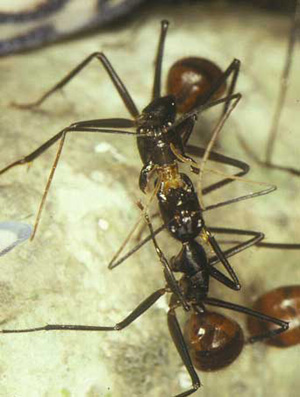 |
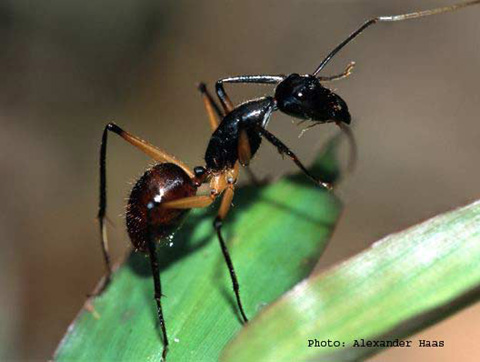 |
| Gambarajah 1. Penukaran makanan berbentuk cecair di antara dua pekerja C. gigas (foto M. Pfeiffer, Uni Ulm). | Gambarajah 2. Pekerja Camponotus gigas borneensis dari Sarawak (Hakcipta foto Profesor Alexander Haas, University of Hamburg). |
Ini adalah ciri yang ketara pada semut Malaysia ini. Ramai saintis menjalankan pelbagai kajian terhadap tingkahlaku, ekologi dan sejarah hidup (Tho, 1981; Gault, 1987; Chung and Mohamed, 1993; Levy, 1996; Orr and Charles, 1994; Orr et al., 1996, Yamane et al. 1996, Pfeiffer, 1997a,b, 1998, 2000, 2001). Camponotus gigas adalah pengumpul makanan berpusat, yang mempunyai struktur ekonomi polidomus, dan dengan kombinasi komunikasi yang efisien, ergonomic yang optimal, ploiteime dan sistem pengambilan ahli yang efektif untuk mengoptimakan pengumpulan hasil. Sub-kasta pekerja-pekerja khusus dalam mengangkut makanan dari keliling sarang ke tengah-tengah sarang ratu ( Pfeiffer and Linsenmair, 1998). The aseasonal nuptial flight pattern of C. gigas shows phase shifted reproductive cycles and a circasemiannual rhythm with a period of 188 ± 5 days, which points towards a strong endogenous component ( Pfeiffer and Linsenmair, 1997). The result is a shifting cycle of reproductive flights, so the time of mating flight is changing within years. This kind of pattern is only possible in tropical ants that live in a more or less constant environment. The territorial behavior of giant ants consists of long lasting ritual fights (see Fig. 3) between a few specialist majors that meet at fixed tournament places.
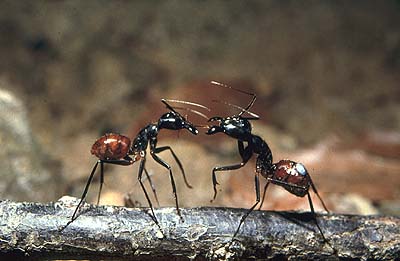
Gambarajah 3. Dua semut gergasi dalam acara perlawanan yang hebat (Photo M. Pfeiffer, Uni Ulm)..
A handful of ants can meet every night and fight over hours in a ritual manner. These permanent fights can last several months (Pfeiffer and Linsenmair, 2001). Interspecific territorial borders are guarded at special bridgepoints (see Fig. 4), e.g. at the tree trunks.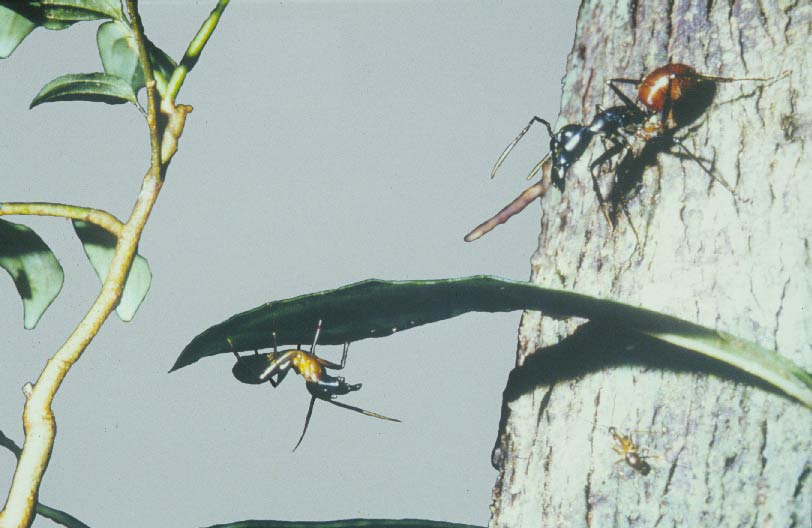
Gambarajah 4. Sempadan di antara kawasan Camponotus gigas dengan spesis Camponotus yang tidak dikenali. Askar C. gigas sedang batang pokok, sekali gus menghalang spesis-spesis lain daripada sampai ke kanopi.
Colony structure is flexible, comprising between 8 and 14 mostly subterranean nests (Pfeiffer, 1997). Pfeiffer and Linsenmair (2000) studied the life history of C. gigas in detail, providing the following information: The best studied colony had a territory of 0.8 ha and a population of ca. 7000 workers, distributed unevenly among an average of 11 nests. Workers are bimorphic, majors on average weighed 372 mg and minors 135 mg. The castes differ in morphology particularly by allometric growth of the head (mean head width 6.93 mm and 3.56 mm). Foraging is mainly nocturnal. At dusk large numbers of foragers (between 35 and 2287) leave single nests within 75 minutes of the onset of foraging and invade the canopy. Through night time many workers commute between the canopy and the nests and all are returning home by dawn. During the daytime foraging is reduced and is restricted to a much smaller number of workers which roam the forest floor. C. gigas (lihat gambarajah 5) mengutip titisan manisan (honeydew) (90%), serangga dan tahi burung (Pfeiffer and Linsenmair, 2001).
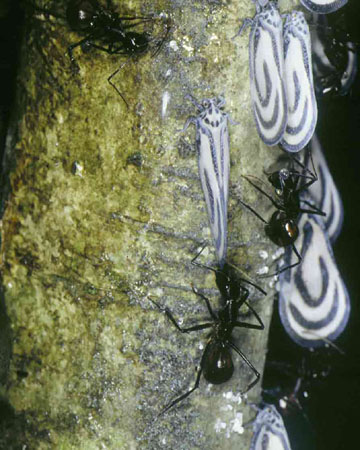
Gambarajah 5. Pekerja-pekerja sedang menjaga Flatidae Bythopsyrna circulata dewasa (Foto M. Pfeiffer, Uni Ulm).(Photo M. Pfeiffer, Uni Ulm).
Kajian
Kembali ke rumusan "ekologi"




